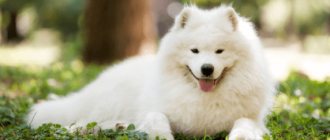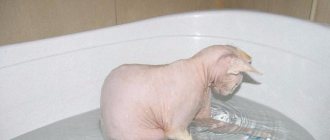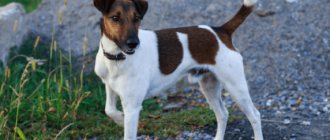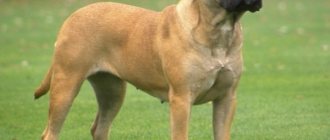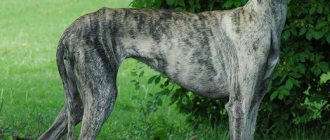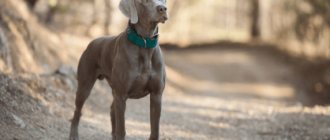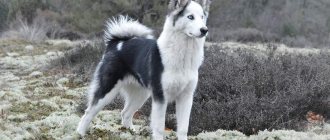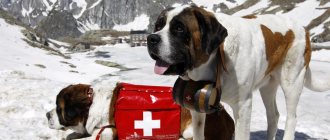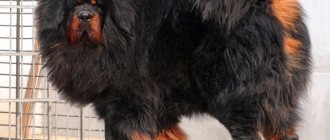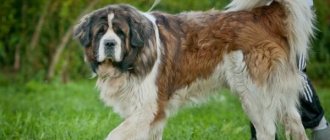Peculiarities
- The Havanese Bichon is a companion dog and is happiest when someone is around. She will suffer from separation anxiety, so someone needs to keep her company throughout the day.
- Although they quickly outgrow it, Havanese Bichon puppies tend to eat their own feces. Clean up after your puppy immediately after he goes to the toilet to discourage him from this unsightly habit.
- The long, silky coat of the Havanese looks beautiful, but requires regular grooming. Many owners prefer to keep it short, otherwise you will have to invest time in grooming or money in paying a groomer. Another reason to leave the coat long: If you live in a warm climate, it will help keep your dog cool.
- Havaneses do well in all types of housing, from apartments to houses with large yards. When they see a passerby or hear a strange noise, they begin to bark obliviously. The good news is that they don't bark for fun.
- Havanese love to look at the world from above and often climb on tables and the backs of sofas to watch what is happening.
- Playing with paper is the Havanese Bichon's favorite pastime. This smart little dog will diligently search for it, even in the jackets and bags of your guests. Shredding a toilet paper roll can keep her busy for hours. Give your Bichon this opportunity, and soon your home will look like a place where a lot of confetti was used.
- Havaneses require as much exercise as larger dogs. A long daily walk can satisfy these needs.
- To get a healthy dog, never buy a puppy from an irresponsible breeder or pet store. Look for a breeder who can provide evidence that the parents do not have genetic diseases that could be passed on to the puppies.
Dossier
Height at the withers of an adult: no higher than 27 cm. Weight: 4.0-7.0 kg. Characteristic color: white, white with black, black, spotted, silver, gold, yellow-brown, tobacco, mahogany. Coat length: long-haired, but requires virtually no grooming. Life expectancy: up to 15 years. Pros: Very friendly and obedient. The character is cheerful and flexible. The Cuban is intelligent and loyal, characterized as a Velcro dog. Easy to train. A good watchman, but not a security guard. Difficulties: Loves and trusts everyone, including strangers. Can't stand loneliness. Capable of being cunning. He is overly talkative and has a penchant for paper - he can spend hours tearing it into small confetti. Average price: $350. Classification: a breed of small dogs from the lapdog group, classified as decorative and companion dogs.
Types and standard
One of the exclusive features of dogs such as Havanese Bichons is their gait - like on springs and with their head always held high. The explanation is very simple: the forelimbs are shorter than the hind legs.
The body proportions of a purebred dog are very important for those who are going to exhibit it. It is important to know that the height at the withers and the length of the body from shoulder to buttock have proportions of 3/4. The body and head are related to each other as 7/3. Height: 23-27 cm. Weight: 3 – 5.5 kg. The body is compact with stronger bones than other ornamental breeds. The tail is of medium length and carried high. The head is not large.
The transition between the body and the head is quite clearly revealed. The eyes are large, oval, only black or brown. Another color is a deviation from the standard. The color can be any. Bite: The upper teeth fit tightly to the lower teeth. The ears hang along the cheeks, are of medium length, set far apart and covered with thick hair.
Story
After Columbus began to claim that Cuba was Spanish territory, Spanish settlers began to arrive there. With them came their small companion dogs - the ancestors of modern Havana Bichons.
These dogs were bred in isolation from other breeds on Liberty Island until the Hawaiian Bichon we know today was created. The hallmark of the breed was its long, silky coat, which protected the dog from the tropical sun.
By the early 1800s, Havanese became members of many aristocratic families in Cuba. European travelers, fascinated by the breed, brought the dogs back to England, France and Spain. The breed became fashionable in Europe in the mid-1800s, and famous fans included Queen Victoria and Charles Dickens.
Like many breeds, the Havanese Bichon has experienced a severe decline in popularity. At one point, the breed almost disappeared, even in its native Cuba. A few Cuban families still kept and bred Bichons, but during the Cuban Revolution of 1959, 11 dogs were brought to the United States as refugees. These dogs are the ancestors of most Havanese outside of Cuba.
The breed's revival began in the 1970s, when an American dog breeding couple found descendants of 11 dogs that had been brought from Cuba. Fascinated by their intelligence and friendliness, breeders began to work to revive the breed.
Since most Havanese outside of Cuba trace their ancestry back to only 11 dogs, breeders are working to expand the breed's gene pool.
The American Kennel Club officially recognized the breed in 1995.
History of the breed
Havanese Bichons are a relatively young breed.
Its ancestor is considered to be the “little white dog from Havana.” It is said that the ancestors of the Havanese Bichon were brought to Cuba by Spanish emigrants. For the most part, these were wealthy or noble people who took pets from Europe - bichons, small white dogs. Some of the visitors arrived from the Canary Islands and brought with them similar dogs. No one carried out special work on breeding the breed. Dogs similar to each other simply crossed, and a new breed naturally appeared. They were small dogs with long, thick hair that protected them from overheating in tropical conditions.
When the revolution took place in Cuba in 1959, the emigrants took only eleven dogs to the United States.
Similar breeds
Maltese (Maltese) is an affectionate, cheerful dog with perfectly white, elegant fur. She has a sensitive, good-natured character, but strangers often frighten her or cause aggression.
Bichon Frize are playful, sincere and intelligent miniature dogs similar to the snowy white poodle, making a wonderful gift for yourself or a loved one.
The Coton de Tulear is a small decorative dog with lush “cotton” fur, originally from the island of Madagascar. Related to Bichons, they are included in the same group of decorative dogs.
Bolognese is a “French lap dog” of Italian origin. He inherited a charming appearance from lapdogs, and a curly coat structure from poodles.
Shih Tzus are traditional Chinese dogs, their homeland is Tibet. Like the Maltese, the Chinese lion cub has the longest fur in relation to the body.
History of the origin of the breed
There are two versions of who the Havanese may come from - the official and the alternative. According to the official version, they were obtained from matings of Maltese and Italian lapdogs (Bolognese), which came to Malta with settlers and colonialists from Spain. But this cannot be confirmed. According to an alternative version of the origin, the Havanese descended from the Tenerife lapdog, which crossed with other lapdogs and poodles in the Canary Islands.
The Cuban aristocracy welcomed the Havanese Bichon, but at the beginning of the 20th century the breed began to die out. It was preserved only thanks to the efforts of American amateurs who bred lapdogs.
The end of the 20th century became the time of the conquest of Europe for the Havanese. Here they have become popular not only among professional dog handlers, but also among amateur owners due to their calm but friendly character.
The Havanese Bichon is the national breed of Cuba.
Character
Havaneses are gentle and affectionate dogs that are especially good at making friends with people.
Your Bichon will follow you from room to room throughout the day and will become anxious if left alone. He's very smart, but can make you laugh with his silly antics, or just sit on your lap watching the world go by.
Temperament depends on a number of factors, including heredity, training and socialization. Puppies with a good temperament are curious and playful and approach people without fear. Choose a puppy with average activity, not one who bullies his littermates, but also not one who hides in the corner.
If possible, talk to the puppy's parents to make sure you feel comfortable with them. It is also useful to observe the puppy's relationship with its relatives to assess its character in the future.
Like any dog, the Havanese Bichon needs early socialization - perception of sounds and sights, communication with people and other animals. Take him to places where he can polish his social skills.
Care and maintenance
The Havanese is one of the few dog breeds that are strictly prohibited from any type of haircut. Therefore, the long curly hair of the Bichon needs special care, which consists of the following:
- bathing as needed;
- regular combing;
- selection of high-quality, correct shampoos, conditioners and balms.
A healthy dog sheds sluggishly throughout the year; more intense shedding occurs only in spring and autumn. Another feature of the Havanese is the absence of a specific smell, which inevitably accompanies dogs of other breeds. The fluffy fur of the Havanese allows him to feel comfortable in the summer heat, but in winter these babies need warm clothes.
The Havanese's ears also require regular care. The hair growing inside must be removed, otherwise it will clog the ear canals.
Wax accumulated in the ears is removed with cotton swabs soaked in a special lotion. Once a month it is necessary to trim the nails, but this must be done extremely carefully so as not to damage their inner part. Usually 1-2 mm is cut off. The baby's eyes are wiped with clean cotton swabs, removing any remaining tears.
The bangs are collected into neat ponytails, fastening them with a soft elastic band.
The Havanese Bichon feels best in a cozy country house or city apartment. The dog needs daily walks, and it is advisable to let him run around without a leash for a while. The little miracle also needs to arrange a comfortable sleeping place and buy him special toys. In the kitchen, the pet should also have its own corner where it will eat.
Housing for a dog
The Bichon Havanese will easily take root even in a small apartment, and a private home will become a luxury for him. Choose a corner for the new family member, preferably not in a walk-through room, so that the dog does not disturb anyone. Buy him a lounger, a special basket or a house, just choose durable materials, otherwise the puppy will tear the object with his sharp teeth. The bowl can be placed near the sleeping area, or in the kitchen.
The water bowl should always be filled, and there may also be a snack nearby in the form of dry food. Dishes for the dog must be taken with clamps, otherwise he will turn the bowls over. You can also take rubber teeth sharpening toys for puppies.
Features of care and maintenance
Despite their long hair, Bichons do not require painstaking care.
- The dog must be brushed every day using a brush and comb. The undercoat is short, the animal sheds little, which is considered a big plus for owners.
- You can cut your hair if you wish, it is not necessary. A classic haircut involves minimal shortening of the coat so that the dog does not look angular. The fleecy cover on the head and tail is deliberately left long. The fur in the area of the paws is trimmed so that the dog can move comfortably.
- You can bathe pets no more than 1.5-2 times a month. Sometimes the procedure is carried out less frequently, depending on the weather outside and the contamination of the animal.
- Bichons' eyes are a weak point and require constant cleaning. As soon as souring occurs, wipe them with a cotton pad and water.
- Brush your teeth every day with a toothbrush.
It is important to do grooming procedures, including trimming nails and treating ears. Carry out events as needed, usually at least once a month
Bichons take root well in apartment conditions, even in one-room dwellings. Your pet should have a bed, not in the walk-through room, but in the corner. A rookery can be bought at a zoological store; it can be a special basket or house. Products must be made of durable materials so that the animal does not damage the bed with sharp teeth. A private home will become a real haven for the dog. If he lives in an apartment, you can take him with you to the dacha.
Place the bowl near your sleeping area or kitchen. Change water as needed. The dishes must be clean, otherwise the animal will not eat from them. You should provide your dog with snacks in the form of dry food. Take food containers with fasteners, otherwise the lapdog will turn the bowls over. Buy rubber toys for puppies to sharpen their teeth.
Hygiene and grooming
During the off-season, Havanese dogs shed frequently. A specific odor may appear and frequent bathing will be required. Wash the animal with special products so that the coat remains smooth, fluffy, and the skin is not irritated. You can also use conditioners for dog hair.
How to feed a Havanese Bichon
A balanced diet is the key to the good condition of your four-legged friend and his good health. The Havanese should be fed only high quality dry food, or a combination of artificial nutrition and natural food.
For the first 6 months, the animal is fed 6 times a day. After that, 2 times is enough. The following products should not be given:
- sweet;
- conservation;
- sausages;
- alcohol.
Bichons should have a separate menu from their owners, replete with variety. Porridge, vegetables, cottage cheese, meat, fish are perfect.
Walking and physical activity
Havanese dogs do not need long walks. The breed is miniature and not particularly strong. Bichons do not need physical exercise, only at their request. If the weather is bad outside, you can use a tray or disposable diapers to carry out the dog's needs. Pets have a hard time withstanding low temperatures; you should not take them out for walks in the cold.
Health
Havanese Bichons are generally healthy dogs, but like all breeds, they are prone to certain health problems. It is important to be aware of possible health conditions if you are considering purchasing a Havanese Bichon puppy.
Buy your puppy from a good breeder who will tell you about the health problems of his parents, and also provide all the necessary evidence that they have been tested and treated. Request certificates confirming the absence of hip dysplasia, elbow dysplasia, hypothyroidism and von Willebrand disease, as well as the absence of eye problems.
- Hip dysplasia : This degenerative disease causes weakening of the hip joint due to abnormal growth and development. This disease occurs in many breeds of dogs. Although it is a genetic disease, there are methods to produce healthy puppies from affected parents. Treatment includes medications, diet, or surgery.
- Elbow dysplasia : Elbow dysplasia is similar to hip dysplasia. This is a degenerative disease that affects the elbow joint. It is thought to be caused by abnormal growth and development, causing the joint to form incorrectly and weaken. The disease can vary in severity. Treatment includes surgery, medications, and diet to control weight.
- Chondrodysplasia : This is a genetic disorder that is commonly described as "dwarfism". Affected dogs have abnormally short limbs for the breed. The disease can vary in severity. In the least severe cases, the dog can live a full life, but should not be used for breeding.
- Legg–Calvé–Perthes disease : The disease causes deformation of the cartilage of the hip joint. It begins with a decrease in blood supply to the head of the femur until it dies, becomes deformed and collapses. The result is arthritis or inflammation of the hip joint. It is not yet clear what causes the disease, but it is believed to be hereditary or as a result of injury. Treatment includes rest, physical therapy, and surgical removal of the deformed femoral head. Dogs generally do well after surgery or experience only mild lameness when the weather changes.
- Cataract : This is an opacity of the eye's lens that can lead to vision loss. The affected eye has a cloudy appearance. This is a hereditary disease that usually appears with age. Cataracts are treated with surgery.
- Deafness : Deafness brings many problems for both the dog and its owner. Some forms of deafness and hearing loss can be treated with medications and surgery, but deafness usually has no cure. You should be patient with your deaf dog, but there are some devices you can purchase, such as vibrating collars, to make it easier for you to communicate with him.
- Patella luxation : is a common problem in small dogs. It occurs when the three-part kneecap is not aligned correctly. This causes lameness or abnormal gait. Treatment usually involves surgery.
- Portosystemic shunt : Occurs when there is abnormal blood flow when blood from the digestive tract continues to flow through the veins, bypassing the liver. When this happens, toxins that are normally removed by the liver are distributed throughout the body, leading to other diseases such as hepatic encephalopathy. Portosystemic shunt usually occurs in combination with another disease. Symptoms include poor balance, loss of appetite, lethargy, blindness, depression, weakness, seizures, confusion and coma. Diet changes and surgery may help correct the problem.
- Heart murmurs : occur as a result of bleeding disorders. There are five types of heart murmurs, which vary in severity. A heart murmur may be an indicator of another disease. Treatment is necessary, which may include medications, special diets, and limited exercise.
- Mitral valve regurgitation : Mitral valve regurgitation is more common in older dogs when the mitral valve, which sits between the left atrium and the ventricle, begins to malfunction. When this happens, the mitral valve does not block blood flow into the left atrium. This can lead to heart failure. Symptoms include hypertension, fluid in the lungs, and decreased heart muscle strength. Treatment involves changing your diet and limiting exercise.
Appearance
The Havanese Bichon is a small but quite strong dog. The minimum height of an adult representative of the breed reaches 21 cm, and the maximum is 29. Moreover, the dog’s weight can range from 3 to 5.5 kg. An important parameter of the Havanese Bichon is the ratio between the length of its body and its height, which have a ratio of 4:3. And the length of the lap dog’s muzzle is equal to the distance between the occipital protuberance and the base of the nose.
The head of the Havanese Bichon has a round, slightly flattened shape. The transition from the broad forehead to the muzzle is quite pronounced. The lap dog's muzzle gradually tapers towards the black nose. The animal's thin lips fit tightly to its white teeth, which have a scissor bite. The dog's cheekbones are quite flat and practically do not protrude.
The Havanese's eyes, in comparison with its overall physique, appear large. They are almond-shaped and planted at a short distance from each other. The eye color is dark, but not black, but closer to brown. The dark edging of the eyes, which can be black or brown, of a dark shade, gives expressiveness to the animal’s look.
The Havanese Bichon's ears are set quite high. They hang freely along the animal's cheekbones and are of medium length. The tips of the ears are slightly rounded, and their entire area is densely covered with hair. The small compact head and slightly elongated body of the dog are connected by a short, strong neck.
The length of the body of the Havanese Bichon is slightly longer than its length at the withers. The dog's back is straight and slightly arched in the lumbar region. The dog's croup has a noticeable slope, and the stomach is well tucked, without sagging. The lapdog's tail is of medium length, set high and tucked behind its back. It is abundantly “furred” and has a dewlap consisting of long hairs of wool.
The Havanese Bichon's legs appear short in comparison to its overall build. The front and rear legs are straight and parallel to each other. They have strong bones and give the animal light gait. The dog's paws seem slightly oblong, they are small and gathered into a ball.
Coat and color
Wool is the main decoration of the Havanese Bichon. It is very long and extremely soft. The length of the top coat hair of a Havanese dog reaches 18 cm. The hairs can be straight or have a “wave”. Wavy hairs form beautiful curls that give the dog a special charm.
Long hair covers the entire body of the lapdog. On the neck and head of the animal, curls of fur create a mane that hides the transition from the head to the body. Often the long hairs of the coat cover the eyes of the lapdog, for which they are tucked into cute ponytails. The fur on the tail creates a chic dewlap, and the ears have feathering.
The Havanese Bichon breed is characterized by two types of coat colors. Pure white, the classic coat color is quite rare today, so the main color of animals is murugi of various shades. The color range of shades of this color varies from very light to brown and red. Spotted colors are characterized by the presence of light spots on the dark “fur coat” of the animal.
The Havanese Bichon is primarily a decorative breed of dog that is accustomed to the company of people and comfortable living conditions. The dog feels great both in a large and noisy family and as a companion for a lonely person. The lapdog, becoming attached to its owner, has a hard time withstanding loneliness, so this breed is not suitable for busy people.
The dog subtly senses the owner’s mood and will not bother you, demanding attention.
The Havanese is absolutely devoid of aggression and is not inclined to dominate other pets. If a pet already lives in the house, then he will definitely “find a common language” with the lapdog.
The Havanese Bichon will make friends with children and will happily share all their games. The only thing you need to worry about is that children do not offend the small dog.
Due to physical characteristics, a lapdog cannot be a full-fledged watchman. With its ringing bark, the dog will only signal the arrival of strangers. The dog treats strangers without aggression, but with distrust. Seeing that the person is friendly and does not pose a threat, the havanez relaxes and feels free. To prevent the dog from becoming overly fearful, early socialization is recommended.
The Havanese Bichon is a fairly intelligent dog that lends itself well to training and education. Representatives of the breed can often be seen in the circus arena, where dogs perform quite complex tricks. They take part in dog competitions and take prizes at animal shows. During training, the dog may show persistence and disobedience, which can be stopped with treats and a kind word.
Description
Similar to other Bichons, but still different. When they are described, they most often use epithets: graceful, magical, fluffy. As befits decorative dogs, they are quite small.
At the withers they reach 22-29 cm, but ideally 23-27 cm. Most Havanese Bichons weigh between 3 and 5.5 kg, but they can weigh up to 7 kg.
Proportional, they can hardly be called stocky, but they are definitely stronger than most decorative breeds. Their legs are short and their body is long, but not to the same extent as a dachshund. The tail is of medium length, carried high and carried over the back.
The muzzle is hidden under abundant fur, but the head is of medium size. At the same time, the stop is quite pronounced and the transition between the head and muzzle is more reminiscent of poodles than bichons. The eyes are large, oval and should be dark in color.
In most dogs they are hidden under the fur, but some owners trim it. The ears are also hidden under the fur and form the outline of the head. They hang along the dog's cheeks and are of medium length.
The main feature of the breed is its coat. It is double, and each layer is very soft. There are not many breeds whose coat is as soft as the Havanese. In hot climates, it is not used for heating, but as an umbrella to protect the dog from the sun's rays. This also means that despite their thick coat, Havanese Bichons need to be protected from the cold.
It is long throughout the body, but should not touch the ground. It forms a mane on the head and neck, hiding the transition to the body. Often the hair covers the eyes and for show dogs it is removed, secured with an elastic band, while for others it is simply cut off.
The coat is wavy, but the degree of wavy varies from dog to dog. It forms gorgeous feathers on its tail. Those Havanese lapdogs that are kept for inserts are practically not cut, with the exception of the paw pads. But domestic ones can be trimmed.
In recent years, puppies with unique coats have been appearing. They are called smooth-haired Havanese or Shavanese. Although each puppy is unique, in general they have much shorter hair. It is not that short, but it is significantly inferior in length and splendor to the classic Havanese.
They have long feathers on their paws and tail, but there is much less hair on their face. Otherwise, they are no different, but they are not allowed to participate in shows and breeders refuse to breed them.
They can be of any color, which gives them a special chic. Moreover, it can be not only one-color, but also with spots of any color. Usually these are light spots on the stomach, paws, and face.
Breed standard
Very respectable and beautiful, the Havanese or Havanese comes in all the colors of the rainbow. From black and white to chocolate and silver, with all sorts of shade options. But the most distinctive physical feature is the unique silky, glossy coat: long, soft, weightless and serves as protection from the scorching rays of the sun. The table shows the main parameters of the dog.
| Options | Description of the breed |
| Head | Medium size, proportional to the length of the entire body. |
| Muzzle | Wedge-shaped, tapering evenly towards the tip of the nose. |
| Neck | Medium size, smooth transition to the withers. |
| Ears | Long, hanging, high set. Covered with wavy fur. |
| Eyes | Large, almond-shaped. The color of the iris is dark brown. The eyelids have a dark edging. |
| Cheekbones | They don't stand out. |
| Nose | The nasal planum is dark brown or black. |
| Lips | Tightly fitting, thin, with a clear edge. |
| Bite | Scissor-shaped. A full set of teeth is desirable. |
| Frame | The back is straight, slightly raised at the withers, and lowered at the lower back. The belly is lean. |
| Limbs | Straight, graceful forelimbs. The hind limbs are longer than the forelimbs, strong, but not powerful. |
| Paws | In the shape of an oval, the fingers are tightly closed into a ball. |
| Wool | The undercoat is poorly developed or not at all. The coat is silky, wavy or straight. |
| Tail | Raised high, saber-shaped or curled into a ring. |
| Color | White. Presence of spots of different colors. |
| Movements | Lightweight, fast. The hind legs provide the propulsion force for movement. Forelegs – precise straight movements. |
The Havanese Bichon dog breed is subject to disqualification if the following signs are present:
- Incomplete set of teeth.
- Bite: overshot or undershot.
- Absence or weak pigmentation of the skin of the lips and around the eyelids.
- Coarse wool or subject to trimming or shearing.
- Straight hanging tail.
- Deformation (curvature) of the paws.
- Small, deep-set eyes.
- Eye color other than dark brown.
Care and care
Although the Havanese Bichon is a small breed, it has a lot of energy. Daily long walks and active play will keep your Havanese happy.
Havaneses do well in any type of home, from an apartment to a single-family home with a large yard, but they should not live outdoors. Bichons do best when they are with their family. They are overly prone to high-pitched barks, so if your home doesn't welcome a lot of noise, this may not be the breed for you.
The desire to please his owners makes the Havanese amenable to training. It is recommended that basic obedience classes be given starting at an early age. Crate training can be particularly difficult for the Havanese Bichon, so be patient during this process.
Separation from the owner can cause serious anxiety. The best way to deal with this problem is to completely eliminate your pet's loneliness. Don't leave your dog alone for long periods of time, but if you need to go away, provide plenty of sturdy toys to keep him occupied for a while.
Although the Havanese Bichon is small and fluffy, it is not a toy at all. Like any dog, he needs to be taught good manners. Don't feed him your leftover food or hold him in your arms all the time, otherwise he will get fat and become overly dependent on you.
Education and training
In order for an animal to grow up healthy and strong, it is necessary not only to follow the rules of care and feeding, but also to purchase healthy and strong puppies. Breeders recommend buying a dog at the age of 2 months. Rehoming a pet earlier will have a negative impact on its mental and physical condition. Experts recommend purchasing from professional breeders or specialized nurseries that breed purebred dogs. The selected pet must have a passport and immunization card, and also have the following characteristics:
- activity;
- playfulness;
- increased interest in the surrounding world;
- the presence of light and transparent eyeballs without mucus and pus;
- no signs of skin diseases;
- presence of correct body proportions;
- a good appetite;
- curiosity;
- the presence of dark pigmentation in the area of the eyelids and nose;
- the presence of strong, strong and smooth limbs;
- absence of lameness and pain during stroking.
We suggest you read: How to teach a puppy not to be afraid to walk on the street without conflicts and offenses.
Experienced dog breeders do not advise turning to unverified sellers, or buying a pet at an inappropriately low price. You should pay attention to both the puppy’s behavior and its habitat and the food products used. If there are even minor deviations from sanitary and hygienic standards, the transaction must be abandoned.
Often, professional breeders not only help to make the right choice and talk about all the intricacies of caring and feeding the animal, but also continue to visit new owners over a long period of time and check the condition of the dog.
In order for your pet to please not only with its appearance, but also with its obedience, the process of education and training must begin from the first days of its stay in the house. Smart animals quickly master all commands and begin to understand their owner perfectly. With long-term training, this breed is able to fetch things on demand, overcome obstacles, perform tricks, and also turn lights on and off. This feature of animals is often used by circus workers, involving dogs in circus acts and entire performances.
Learning commands and rules of conduct should take place during the game and not be didactic in nature. Regular rewards with treats and praise for correctly executed commands and good behavior will force the pet to fully devote itself to the learning process.
Beginning dog breeders should know that the appearance of a Havanese in the house will bring not only a huge amount of positive emotions and fun, but also a number of certain difficulties associated with caring for and feeding the animal. Working people who spend most of their time outside the home are better off refusing to buy, but families with children who are willing to devote time to training and communicating with a pet can focus their attention on this breed without fear.
Buying a Havanese puppy is a matter that requires a serious approach. First, decide whether you are ready to be responsible for a little creature who will love you with all his heart. If you are a busy person and you don’t have time to walk and take care of your pet, then maybe you should postpone the idea of buying a puppy until better times?
How much does a Havanese Bichon puppy cost? The price for representatives of the breed depends on the class of the puppy and the popularity of the kennel. The lower price limit is around $150. USA. As for show-class show puppies, their cost is in the thousands.
Experts advise adopting a Havanese Bichon puppy from the age of two months. In this case, you need to ask the breeder for all the necessary documents and certificates, and also carefully examine the dog for compliance with breed standards:
- Head. Rounded skull, with a slight transition to the muzzle from the forehead. Just below the eyes, the muzzle is slightly cut off, but does not look pointed. Strong lower jaw, large nose. The lips are thin and close tightly. The bite is scissor-shaped.
- Ears. Hanging, covered with hair, reaching the middle of the muzzle. Located slightly above the eye line.
- Eyes. Round, dark brown or black, lively and full of curiosity. There is a dark halo around the eyes, giving the eyes a special expressiveness.
- Neck. Set high, long, slightly convex, with a smooth transition to the withers. From the back of the head to the withers, the length of the neck is about a third of the body.
- Frame. Wide, voluminous chest, the lower part of the chest reaches the middle of the paws. The chest is slightly convex. The stomach is tucked.
- Tail. Its length is ½ the length of the back. Covered with abundant hair, it has a curve towards the back.
- Movements. Light, free, with an even rise and fall of the hind and front legs. During movement, the neck and head are kept straight and high.
In addition, a Havanese puppy must have a number of vaccinations. These dogs are susceptible to many diseases, so be sure to ask the breeder for a vaccination certificate.
Already in a couple of months, breeders can give a Bichon puppy to a new family. Here are a few rules for choosing a puppy:
- the dog must be active, he happily explores the world, new smells, a new person, is ready to play and run;
- the color does not change, therefore, which puppy you take, it will remain the same in terms of coat color;
- if there is pigmentation on the nose or eyelids, it will not go away, take this into account;
- puppies should not limp, feel him carefully, make sure that there is no painful reaction to touch.
Take dogs only from trusted breeders - these have documents for the dogs and a pedigree.
Costs range from $300 to $500 per puppy. You can find it cheaper, the main thing is to make sure that you are taking home a healthy animal.
When you have Havanese Bichon puppies in front of you, when choosing him, you need to see how he behaves with his brothers and sisters.
It is better to choose a Havanese who does not get into conflicts or hide behind everyone else. All dogs are playful and curious, but it is better to choose a puppy with average activity.
The Havanese Bichon is a decorative breed. They are often brought to exhibitions, so its appearance is very important. A lot depends on proper feeding. The dog itself will prefer meat and fruits, but you can go in three ways:
- Use good dry food.
- Combine dry food with natural products.
- Stick to natural food only.
Since the dog is small, natural food will not be expensive. This does not mean that the Havanese can be fed from a human table. This is strictly contraindicated. It is advisable to immediately train the puppy not to appear in the kitchen when the family gathers at the table.
Meals should include meat (proteins and fats), cottage cheese (calcium), vegetables and fruits (a source of carbohydrates and fiber). You should feed little by little two to three times a day. Clean water must be available at all times.
We suggest you familiarize yourself with: Cattle weight gain, cost of weight gain
An adult dog should never receive:
- Sweets are both mealy and sugary.
- Sausages that can cause allergies.
- All human food.
Puppies are fed according to certain rules because they grow quickly. They need protein and calcium (special vitamins can be given). Up to six months, puppies are fed 6 times a day, then transferred to three meals a day.
Puppy and adult dog should not be overfed. This is very easy to determine.
You should pet the Havanese and feel his ribs. If you feel them under your hand, then everything is in order. You can also weigh an adult dog for compliance with the standard, after which adjusting the amount of food.
Raising Cuban Bichons
Havanese dogs are amazingly smart creatures, the leitmotif of whose life is to please their owner. Raising a Havanese will not create difficulties or problems even for a beginner. Cubans instantly learn the requirements and rules of residence and try to comply with them. They socialize easily. In love with the owner and all members of his family, the dogs are easily trained: they learn commands and learn simple tricks.
Being the brightest representative of decorative exotics, the Havanese Bichon is surprisingly effective in sports disciplines: agility, flyball, freestyle, obedience.
In America, Cuban Bichons are involved in projects:
- Canistherapy (method of treatment and social adaptation of sick people with the help of specially trained dogs);
- accompanying as a guide dog for a visually impaired person;
- search for drugs and explosives.
Feeding
Recommended daily intake: 0.5 to 1 cup of high-quality dry food, divided into two doses.
NOTE: The amount of food your dog needs also depends on many other factors, such as his activity level, size, build, age and the quality of the food itself.
Keep your Havanese in good shape. His waist should be visible. A more accurate test: place your hand on the dog's ribs; you should feel the ribs without having to press, but not see them. If you can't do this, then your dog has become fat and needs more exercise and less food.
Choosing a puppy
Havanese dogs are most popular in the United States; most nurseries for breeding them are located there. In our country, this breed is rare, but nevertheless, puppies can be found. You should only purchase a baby from a trusted breeder with a good reputation and positive reviews.
Havanese puppies are difficult, but can be found.
It is very difficult to distinguish a small Havanese from other adjacent breeds or just a similar outbred animal, since the puppies of all lapdogs are very similar. Only supporting documents (parental pedigrees, puppy records, etc.) can serve as a guarantee of purebredness.
It is better to avoid buying a cute Havanese dog at a bird market or in a subway passage at a very attractive price, since purebred puppies of this rare breed are not sold that way.
Price of a puppy of this breed
The cost of Havanese babies ranges from 20-40 thousand rubles, it all depends on the birth and title of the parent couple, as well as on the prospects of the upcoming exhibition activities. For show class puppies they ask for more (up to 70 thousand). A pet without documents can be found for 8–10 thousand rubles.
Hygiene and grooming
The Havanese Bichon's coat is heavy, soft and silky, but does not shed easily.
The coat is long and can be either straight or wavy, which is considered more preferable. Coloration varies widely and can be white, black, black and tan, gray and many other colors. Many Havanese owners keep their coat short to make it easier to care for. But if you decide not to do this, then you will have to spend a lot of time and effort to keep it in good condition.
Long coats require daily brushing to prevent frequent bathing and hairballs. A wise decision would be to tie the fur above the eyes into a ponytail, and it also looks very cute.
Unless you are highly skilled when it comes to grooming, it is probably best to seek help from a professional groomer. Owners can learn how to groom their dogs, but also use the services of a professional to keep their pet's coat in good shape.
The Havanese Bichon can often experience watery eyes. Keep in mind that excessive tears may indicate eye problems and require a trip to the vet. However, most cases are not serious and their cause is unknown. It is important to keep the fur around the eyes clean and wipe it daily with a damp cloth.
A Havanese Bichon's teeth should be brushed at least 2-3 times a week to remove tartar and accumulated bacteria and prevent gum disease and bad breath. Daily cleaning is even better.
Trim your nails once or twice a month if they don't wear off naturally. Well-maintained nails will keep your Havanese's paws in good condition and will prevent scratches on your feet and hands.
Start getting your pet used to brushing from an early age. Make brushing a positive experience filled with praise and rewards to lay the foundation for easy veterinary checkups and other procedures.
During grooming, check your dog for sores, rashes, or signs of infection (redness and inflammation of the skin, eyes, mouth, ears). The eyes should be clear and without redness. Weekly thorough checks will help identify health problems early.
Caring for a Havanese Bichon
At first glance at the Havanese, it is clear that the main difficulty in its maintenance concerns coat care. You need to brush your dog every day, spending ten to fifteen minutes on it, or cut your Bichon’s hair shorter. It is necessary to ensure that garbage and insects do not get tangled in the luxurious fur coat of the Havanese, and tangles do not appear. Havaneses are bathed as they become dirty, using special pet shampoos for long, soft coats.
The Havanese should be combed thoroughly with a long-toothed comb.
Another important point is caring for the Havanese ears. Since they are covered with long hair, access to the ears is difficult, meanwhile, under the layer of hairs, an environment favorable for the growth of bacteria develops. Therefore, the owner should regularly clean his pet’s ears, trim excess hairs around the edges of the ears that can get stuck inside, and remove earwax and other contaminants.
As the nails grow, they need to be trimmed using a special nail clipper. It is necessary to carefully trim each claw down to a living spot, and also trim the hair growing between the dog’s toes so that it does not interfere with the dog’s walking.
How to trim a dog's nails?
Another point that is especially relevant for owners of snow-white Havanese dogs is eye care. The yellowish tear tracks are clearly visible on the white fur, and the dog's eyes need to be looked after. Every day you need to wipe your eyes with a cotton pad soaked in boiled water or a special veterinary eye lotion. Traces from tear tracks can be removed with Chlorhexidine or human lens solution.
The Bichon requires regular coat and ear care.
In general, Havaneses do not cause problems related to health, as they are considered the most problem-free in this regard. Havanese Bichons do not have breed or genetic diseases; in addition, they are long-livers and, on average, delight their owners for fifteen years.
Feeding the Havanese Bichon
Both the luxurious appearance and, most importantly, the health of the dog are inextricably linked with a high-quality diet. In the first weeks when the puppy appears in the house, he is fed in the same way as the breeder did. After buying a dog, you should definitely consult about the baby’s usual diet. Next, the owner independently decides which feeding system he likes best: natural products or industrial dry food.
Among owners of Hawaiian Bichons, both types of food are equally common, which have both their advantages and disadvantages.
Table 1. What to feed the Havanese Bichon?
| Ready-made dry food | Natural nutrition |
| The Bichon will benefit from a complete food for small breeds of the “holistic” or “super premium” class. The composition must contain at least 60% fresh meat, poultry or fish. It is better to choose hypoallergenic food from one of the popular brands: Akana, Grandorf, Nau, Go, Barking Hard and the like. When choosing dry food, you need to ensure that it is suitable for the dog’s age, and also that the protein source is listed first in the list of ingredients: turkey, lamb, salmon, duck, trout. Feeding dry food does not mean that the dog will eat other foods: you cannot mix dry food and natural foods. It is necessary to ensure that the animal always has access to clean drinking water | The diet should be based on a source of animal protein; it is best to choose lean varieties of meat and poultry (veal, rabbit, turkey). A couple of times a week you can give your dog sea fish and offal. In a bowl with meat, fish or poultry, you must add raw vegetables and fruits, grated or finely chopped carrots, zucchini, apples, and pumpkin. At least five times a week, the dog should receive lactic acid products: natural yogurt, cottage cheese, kefir. Greens, quail or chicken eggs are also added to the diet. A natural diet means that the animal will additionally receive some vitamins and minerals. This should be discussed with your veterinarian. |
Havanese Bichons thrive on dry food
Training
Any dog must immediately obey the owner's commands.
If you don’t have much experience in training, you should start training your Havanese from three months old. Dogs at this age are like sponges, absorbing everything they are taught. Usually the owner loves the “come to me” command. You need to know that this call is always affectionate. Even if everything inside the owner is trembling because the dog does not obey, but is minding its own business, then you still need to overcome yourself and continue to call the Havanese as tenderly as possible and do not forget to treat him after the command is executed. If he is punished for non-compliance, then this will be fixed in memory, and the dog will not approach. The puppy must know the commands “place”, “come to me”, “near”, “fetch”, “sit”, “lie down”, “stand”. Then it will be very easy to control it on a walk and at home. A smart miniature dog quickly understands the owner’s mistakes and strives to become his leader. The owner should always remember this and always put the dog in second place after himself. This is achieved by strictly following commands. You can practice agility with it, developing speed and dexterity. The Havanese easily learns all the tricks and willingly performs them. When going to the river, never forget about your pet, because he is an excellent swimmer who loves water.
Pros and cons of the Havanese Bichon breed
The advantages of the breed include their unconditional kindness, affection for people and love for children. Bichons are smart and easy-going dogs that are easy to train and educate.
At the same time, if not properly trained, these miniature dogs are capable of serious pranks that can cause a lot of trouble for their owners. A disadvantage of Havaneses can also be considered their extreme susceptibility to diseases, including: cataracts, joint displacement, otitis media, retinal detachment, deafness, liver or heart failure.
Other pets and children
The Havanese Bichon is a wonderful family dog that is affectionate with everyone, including children of all ages and other pets. But due to their small size, they can easily get injured, so it is important to teach your children how to properly handle a dog.
You should always supervise any interactions between dogs and small children to prevent injury to both parties. Teach your child not to approach any dog while it is eating or sleeping. No dog, no matter how friendly, should be left alone with a small child.
Nutrition
The Havanese Bichon can eat both dry and natural food.
However, meat products are preferable. Some Havanese love fruit. It is not allowed to feed them food from the table. Their diet should be balanced. Feed an adult Bichon 2 times a day, remembering to fill the bowl with fresh water. Puppies are fed intensively 6 times a day. Select foods that are high in calories and rich in easily digestible protein.
Along with food, puppies are fed calcium supplements. Once puppies reach 6 months of age, they begin to grow a little slower and can be gradually introduced to three meals a day.
- Sweets, sausages and fried foods should be excluded from the Bichon's diet.
